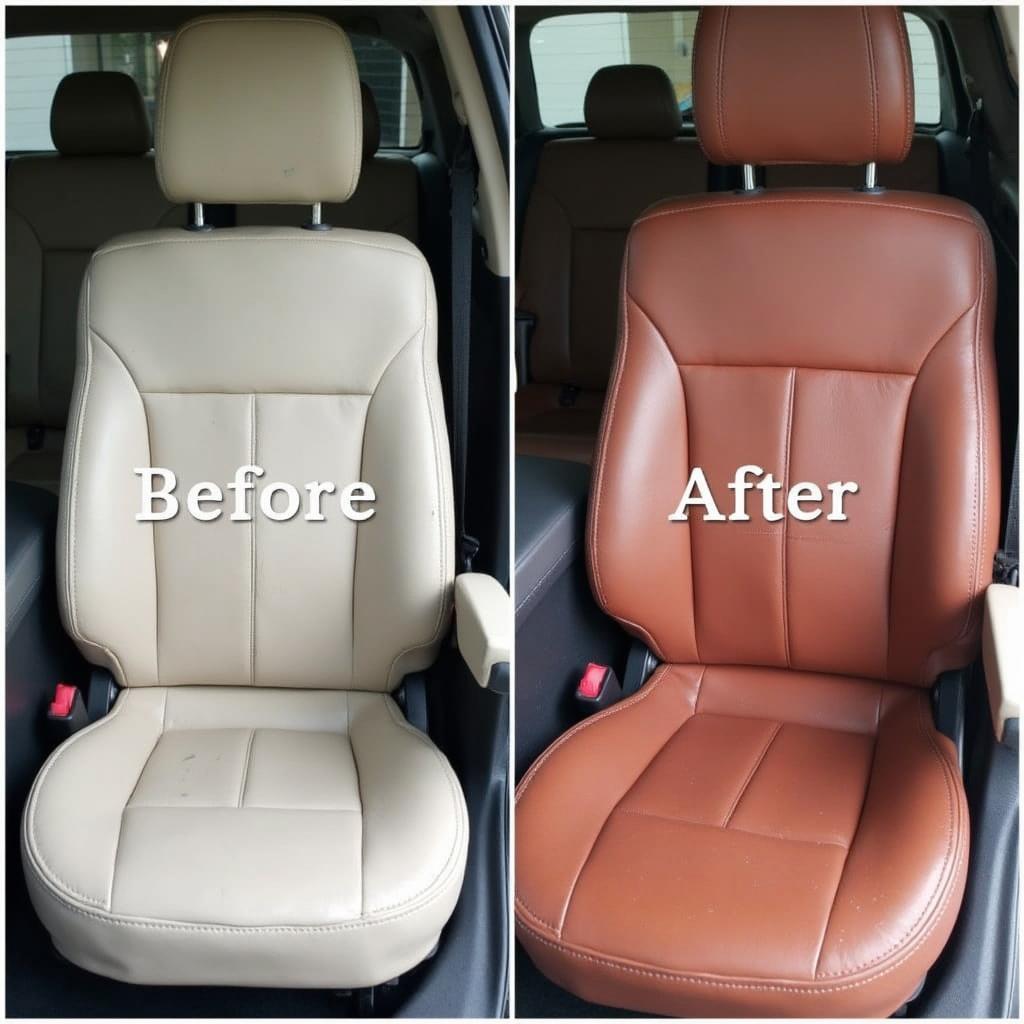Leather car seats are a luxurious and comfortable addition to any vehicle. But over time, they can become scratched, faded, and cracked, detracting from the overall aesthetic of your car’s interior. While professional detailing can be expensive, there are many DIY methods you can use to effectively repair your leather car seats and restore them to their former glory. Whether you’re dealing with minor scratches or more significant damage, this guide will provide you with a comprehensive understanding of how to repair leather car seats using accessible tools and techniques, all while keeping your budget intact.
Assessing the Damage: What’s Your Leather Repair IQ?
Before diving into the repair process, it’s crucial to assess the type and extent of damage to your leather car seats. This evaluation will help you determine the appropriate repair methods and products for your specific needs.
- Scratches and Scuffs: Light surface scratches are the easiest to repair and can often be addressed with simple cleaning and conditioning techniques.
- Cracks and Tears: Deeper cracks and tears require more involved repairs, often involving leather fillers, adhesives, and color-matching techniques.
- Fading and Discoloration: Sun damage and general wear can cause leather to fade and lose its original color. Addressing this issue typically involves cleaning, conditioning, and the use of leather dyes to restore the color.
Understanding the extent of the damage is the first step to a successful DIY leather car seat repair. It’s like giving your car seat a proper diagnosis before prescribing the right treatment!
Gathering Your Leather Repair Arsenal: Tools for the Task
Once you’ve assessed the damage, it’s time to gather the necessary tools and materials for your leather car seat repair project. Here’s a list of essential items:
- Leather Cleaner: Opt for a dedicated leather cleaner specifically designed to remove dirt, grime, and oils without drying out the leather.
- Leather Conditioner: Leather conditioner helps to moisturize and protect the leather, preventing future cracking and fading.
- Applicator Pads and Microfiber Cloths: Use these for applying cleaners, conditioners, and dyes evenly and effectively.
- Soft-Bristled Brush: A soft-bristled brush is useful for cleaning crevices and textured surfaces on your leather seats.
- Leather Repair Kit: For cracks and tears, invest in a leather repair kit that includes leather filler, adhesive, and color-matching compounds.
- Heat Gun or Hair Dryer: Heat helps to set leather fillers and dyes, ensuring a durable and long-lasting repair.
Remember, having the right tools is half the battle! Investing in quality products will ensure optimal results and prevent further damage to your leather car seats.
YouTube to the Rescue: Finding Your Perfect Repair Tutorial
Now that you have your tools ready, it’s time to leverage the power of YouTube. Search for “how to repair leather car seat youtube” and explore the wealth of video tutorials available. Here are some tips for selecting the right tutorial:
- Look for Videos Specific to Your Damage: Focus on tutorials that address the specific type of damage you need to repair, whether it’s scratches, cracks, or fading.
- Pay Attention to Product Recommendations: Many tutorials will recommend specific brands or types of leather repair products, providing valuable insights into what works best.
- Choose Tutorials with Clear Instructions and Demonstrations: Opt for videos with clear, step-by-step instructions and close-up demonstrations that make it easy to follow along.
Remember, watching a few different tutorials can provide a well-rounded understanding of the repair process and help you feel confident in tackling the project yourself.
Safety First: Protecting Yourself and Your Car
Before you begin any repair work, it’s essential to prioritize safety. Work in a well-ventilated area to avoid inhaling fumes from leather cleaners or dyes. Wear gloves to protect your hands and old clothes that you don’t mind getting stained. It’s also a good idea to cover your car’s floor mats and surrounding areas with a drop cloth to protect them from accidental spills or splatters.
By taking these simple precautions, you can ensure a safe and enjoyable DIY leather car seat repair experience.
Expert Insight: A Stitch in Time Saves Nine
“Many car owners wait until their leather seats are severely damaged before seeking help,” says Sarah Jones, a seasoned automotive detailing expert with over 15 years of experience. “Regular cleaning and conditioning are essential for preventing premature aging and maintaining the suppleness of your leather car seats. Addressing minor scratches and scuffs early on can prevent them from developing into larger, more costly repairs down the line.”
Conclusion: Repair, Restore, Rejuvenate
Repairing your leather car seats doesn’t have to be a daunting task. By following the steps outlined in this guide and utilizing the wealth of information available on YouTube, you can effectively address a variety of damage types and restore your leather seats to their former glory. Remember to prioritize safety, invest in quality products, and choose tutorials that align with your specific repair needs. With a little bit of effort and guidance, you can revive your car’s interior and enjoy the luxurious feel of like-new leather seats for years to come.
FAQs: Your Burning Leather Car Seat Repair Questions Answered
Q1: Can I use household cleaners on my leather car seats?
A: It’s best to avoid using harsh household cleaners on leather car seats as they can strip the leather of its natural oils, leading to dryness and cracking. Stick to dedicated leather cleaners for optimal results.
Q2: How often should I condition my leather car seats?
A: It’s recommended to condition your leather car seats every three to six months, or more frequently if they are exposed to extreme temperatures or sunlight.
Q3: Can I repair a tear in my leather car seat myself?
A: Yes, minor tears can often be repaired using a leather repair kit and following the instructions provided. However, for larger tears or complex repairs, it’s best to consult a professional.
Q4: How can I prevent my leather car seats from fading in the sun?
A: Parking your car in the shade, using a sunshade, and regularly conditioning your leather seats can help prevent fading caused by UV rays.
Q5: What should I do if I accidentally spill something on my leather car seats?
A: Clean spills immediately using a soft cloth and a mild leather cleaner. Avoid rubbing the spill as this can spread it further.
Need Help? We’re Here for You!
For expert advice and assistance with your car repair needs, feel free to reach out to us:
WhatsApp: +1(641)206-8880
Email: [email protected]
Our dedicated team of car care professionals is available 24/7 to provide you with personalized solutions and support.


